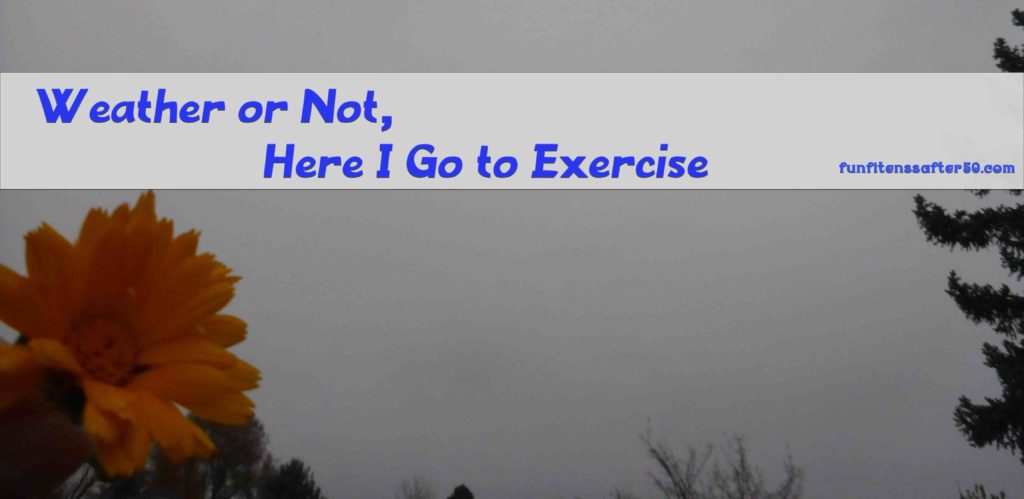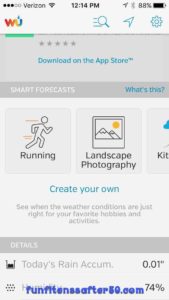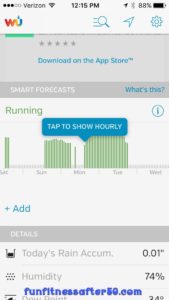[Week 3 of 12 Weeks to a Healthy New Year]
How to think about the weather
Do you have a plan for staying fit in spite of the challenges of winter weather? An effective plan will include:
- being aware of daylight hours
- checking long term weather
- double checking short term weather
- learning to evaluate multiple weather variables
- having weather appropriate gear (which I write about here)
- being mentally prepared for winter conditions
- having long term goals to help motivate you (will be addressed more fully in another post)
- knowing when to adjust your plans
- having ready options when plans need to be adjusted (also a topic for another post)
Literally, where did the day go?
It is ironic that the same celestial phenomena that gives us lovely, long summer days the further we are away from the equator also gives us exasperatingly short daylight during the winter. When I lived in Taiwan, it was weird to have my summer and winter days all end at basically 6:00 PM. But along with the consistent daylight hours came fairly consistent temperatures. Here in Idaho, short days exacerbate the cold, requiring a different sort of attention to outdoor activity.
I know some people who revel in being outside in freezing temperatures, but for most of us, it is helpful to be able to choose the warmest part of the day that will fit with our schedules. For some people, that will limit outdoor exercise to weekends, unless you like something unique like night skiing. For others, there might be a way to fit in lunchtime excursions. Summer may have been too hot for that, but winter may be just right, to misquote Goldilocks.
Make good use of a weather app and knowing the long term forecast
There are lots of weather websites and apps that make it easy to glance at a long term forecast. I am currently using the Weather Underground app. Besides being able to see the outlook for several days, the app also has a smart forecast function. To make use of this, you enter conditions under which you would like to be outside. The app then generates a chart highlighting how well the weather matches those. It is one more way to see at a glance what weather you have to work with.
Even though weather is notoriously unpredictable, weather forecasts are usually at least in the ballpark enough to make a plan for several days. If I know that rain is very likely on the day I have a long run planned, I can adjust things ahead of time or be ready to adjust. Similarly, if I know that heavy rain or snow are likely at a given time, I will be more motivated to take advantage of better weather.
Working with the short term forecast
I like being able to tap a specific day on my weather app and see an hourly summary of expected weather. I usually take advantage of this function just before bed and right when I wake up. Access to more immediate expectations gets me off to the best start of the day. I can make sure I have the right clothes available and figure out if there are scheduling issues to make exercise more possible.
Of course, there is nothing quite like looking outside, then stepping outside, to get the best idea of what weather you will be dealing with right before an outside activity. If there has been a blustery storm, but it clears up, I might just drop everything and go for a 2 mile run.
How all the weather variables go together
The more you exercise outside, the better you will get at evaluating how weather variables will actually feel. Here is my mental checklist:
- basic air temperature
- sunshine
- thickness of cloud cover
- overall humidity
- moisture on the ground
- moisture in the air
- wind speed
- wind temperature
- time of day (affects warming up or cooling down)
After noting each of these, you need to consider how they interact. A windy 52°F (11°C) almost always feels warmer in the sunshine. A drizzling 45°F (7.2°C) will have more impact if it is also windy. Moisture on the ground might end up freezing during an evening run. Also, keep in mind that while being active will help keep you warm for a while, the more tired you get, the more susceptible you will be to cold.
It’s all in your head
It is always harder for me during the first cold days. I have to have a talk with myself and remind myself that
- I will warm up
- I have things to wear
- I can get warm inside some first
- I will feel better
- I will have fun
It is not that I am “willing” these things to happen. They are reality. I just need to remember the information and make good use of it.
When is it an excuse and when it is a good decision?
The truth is, only you can decide how you should exercise. And you are the only one it really matters to. Others can encourage and coach, but the final decisions are yours. It is your body.
If you are making a lot of excuses, maybe you need to adjust what activities you are trying to do. Or how much you are doing. Or when you are trying exercise.
Maybe you need to reevaluate your goals. Are they really your goals or are they your idea of someone else’s expectations? Maybe you need just to feel less stressed about your own expectations and enjoy the process more.
I have found that a peace after I decide to adjust a plan or take a day of rest is a good indicator. If I feel restless or agitated, I probably need to find something to do towards my activity goals.
Of course, if you are sick, that is a pretty good sign that you need to rest. If you are injured, you have to consider alternatives or if it would be best to keep using that body part some.
When weather seems to be the deciding factor, don’t be afraid to test new limits. Or find new things to enjoy. After one large snowfall a couple of years ago, I approached it as an experiment of joy. I tried running a relatively short distance and gave myself permission to feel child-like. I had to learn some new things about traction in the snow, but it was overall a grand experience.
Are you more vulnerable to weather as you age?
I think it is very hard to judge how our age impacts our perception of the weather. It is similar to the question of how much strength do we lose as we age. It is hard to measure because so many people slow down by choice or responsibility. There are many examples of people over age 50 being quite robust. Usually they have made an effort, so it can’t be all attributed to genetics.
To some degree, I think older people just get more impatient with being cold. After all, the winters do add up. And while there is nothing wrong with wanting to be warm, there is nothing that is keeping most of us from moving and staying warm. If we do move more, we will have better circulation overall and that will help keep us warm the rest of the time.
The bottom line is that we can learn to work with the weather to some degree or another….hee hee



